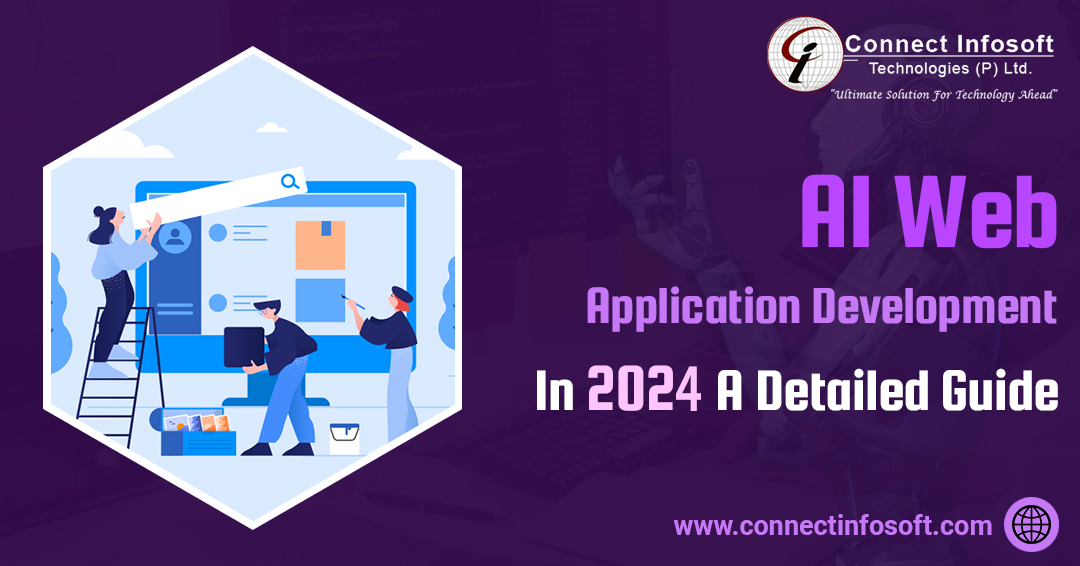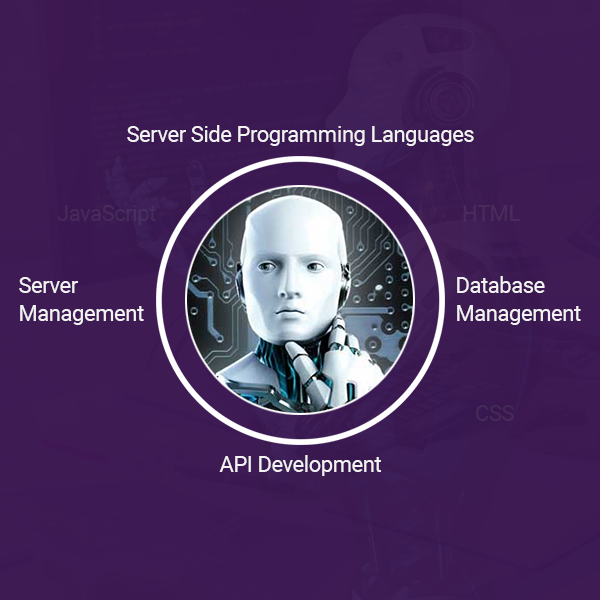AI Web Application Development in 2024 | Connect Infosoft

Web application development has transformed the digital world by providing customers with dynamic and interactive experiences across multiple platforms. In this comprehensive article, we will delve into the world of web app development, beginning with the fundamentals and progressing to complex concepts and technologies.
What Is A Web Application?
A web application, often known as a web app, is a software programmer that runs on a web browser and allows users to interact with it via the internet. It can be accessed via a URL and does not require installation. Web apps are intended to perform a variety of functions, ranging from simple chores like form submissions to complicated processes like e-commerce transactions or collaborative document editing.
What is AI Web App Development?
The process of producing web apps that incorporate artificial intelligence (AI) technology to improve functionality and user experience is referred to as AI web app development. These apps simulate human intelligence by utilizing machine learning methods, natural language processing, and computer vision. AI web app development is critical to fostering innovation and reshaping industries such as healthcare, banking, e-commerce, and customer service, as well as revolutionizing how businesses function in the digital age.
Web Application Types:
There are several types of web applications, each having a particular function. E-commerce web applications, social media platforms, content management systems (CMS), web-based email clients, and project management tools are among examples. These apps address specific purposes, such as facilitating online purchasing, connecting individuals through social networks, managing digital information, or giving productivity tools.
Web Application Benefits:
There are various advantages to using web applications versus traditional desktop applications. They may be accessed from any device that has a web browser and an internet connection, allowing for cross-platform compatibility. Web apps also reduce the requirement for software installation and updates on individual devices because updates are handled on the server. Web apps can also be readily scaled to meet rising user demand by expanding server resources. Because they can leverage current web technologies, they are less expensive to develop than native applications.
Examples of Popular Web Apps
Several well-known online applications demonstrate the adaptability and functionality of this development method. Users can use Google Docs, for example, to create, edit, and collaborate on documents in real time. Trello is a web-based project management software that allows users to organize and monitor projects with the help of boards and cards. Spotify is a music streaming service that provides a large music library, personalized playlists, and suggestions. Airbnb changed the travel business by giving a platform for consumers to book rooms all over the world. Appy Pie is a web software that allows users to quickly create Android and iOS apps.
Front-End Development:
Front-end development refers to the process of creating the visual and interactive elements of a website or web application that users interact with directly. It involves the implementation of the design and user interface, ensuring a seamless and engaging user experience. Front-end developers, also known as client-side developers, play a crucial role in bringing the creative vision of web designers to life and making it functional.
Key Aspects Of Front-End Development Include:
1. HTML (Hypertext Markup Language):
This is the backbone of any web page, providing the structure and organization of content. HTML is used to define the various elements on a webpage, such as headings, paragraphs, images, forms, and more.
2. CSS (Cascading Style Sheets):
CSS is responsible for styling the HTML elements, determining how they look on the page. It controls aspects like layout, colors, fonts, and spacing, ensuring a consistent and visually appealing presentation across different devices and browsers.
3. JavaScript:
As a dynamic scripting language, JavaScript enables interactive and responsive features on a webpage. It allows developers to create functionalities such as sliders, pop-ups, form validations, and asynchronous communication with servers, enhancing the user experience.
4. Responsive Design:
Front-end developers must ensure that websites are responsive, adapting to different screen sizes and devices. This involves using techniques like media queries and flexible grid layouts to optimize the user experience on desktops, tablets, and smartphones.
Back-End Development:
Back-end development is the foundational aspect of web development responsible for creating and maintaining the server-side of websites or web applications. Unlike front-end development, which focuses on the user interface and experience, back-end development deals with server logic, databases, and server-to-client communication. Back-end developers work to ensure that the data and functionalities required by the front end are delivered efficiently, securely, and reliably.
Key Aspects Of Back-End Development Include:
1. Server-Side Programming Languages:
Back-end developers use languages like Python, Ruby, Java, PHP, Node.js, and others to write the server-side logic. These languages enable the processing of requests, business logic implementation, and data manipulation.
2. Database Management:
Back-end developers work with databases to store, retrieve, and manage data. Common types of databases include relational databases (e.g., MySQL, PostgreSQL) and NoSQL databases (e.g., MongoDB). They design and optimize database structures to ensure efficient data storage and retrieval.
3. Server Management:
Back-end developers are responsible for configuring and managing servers. This includes handling server security, scalability, and performance optimization to ensure that the application can handle varying levels of traffic.
4. API (Application Programming Interface) Development:
Back-end developers create APIs that allow different components of a system to communicate with each other. APIs define the rules for how software components should interact, enabling the front end to request and receive data from the back end.
Conclusion:
Web app development provides limitless opportunities for generating powerful and engaging internet experiences. You can embark on a successful web app development journey by mastering the principles, familiarising yourself with crucial technologies and tools, following a disciplined development process, and remaining up to date with developing developments. Accept the challenges and opportunities that come with developing web apps, and let your creativity and problem-solving abilities to change the digital environment. Remember to prioritise user experience, security, and scalability as you continue your web app development efforts to construct robust and meaningful applications. Continue to be curious, to learn, and to enjoy the amazing world of web app development.


